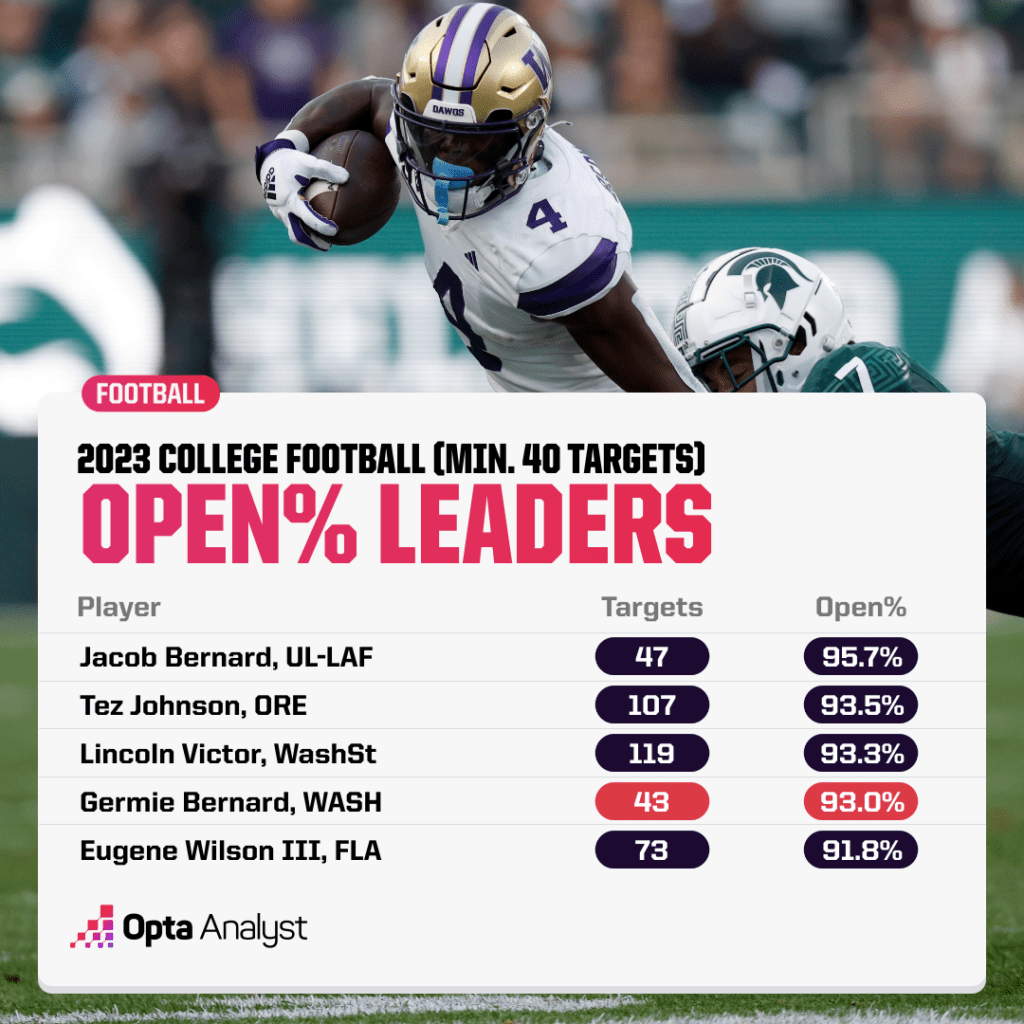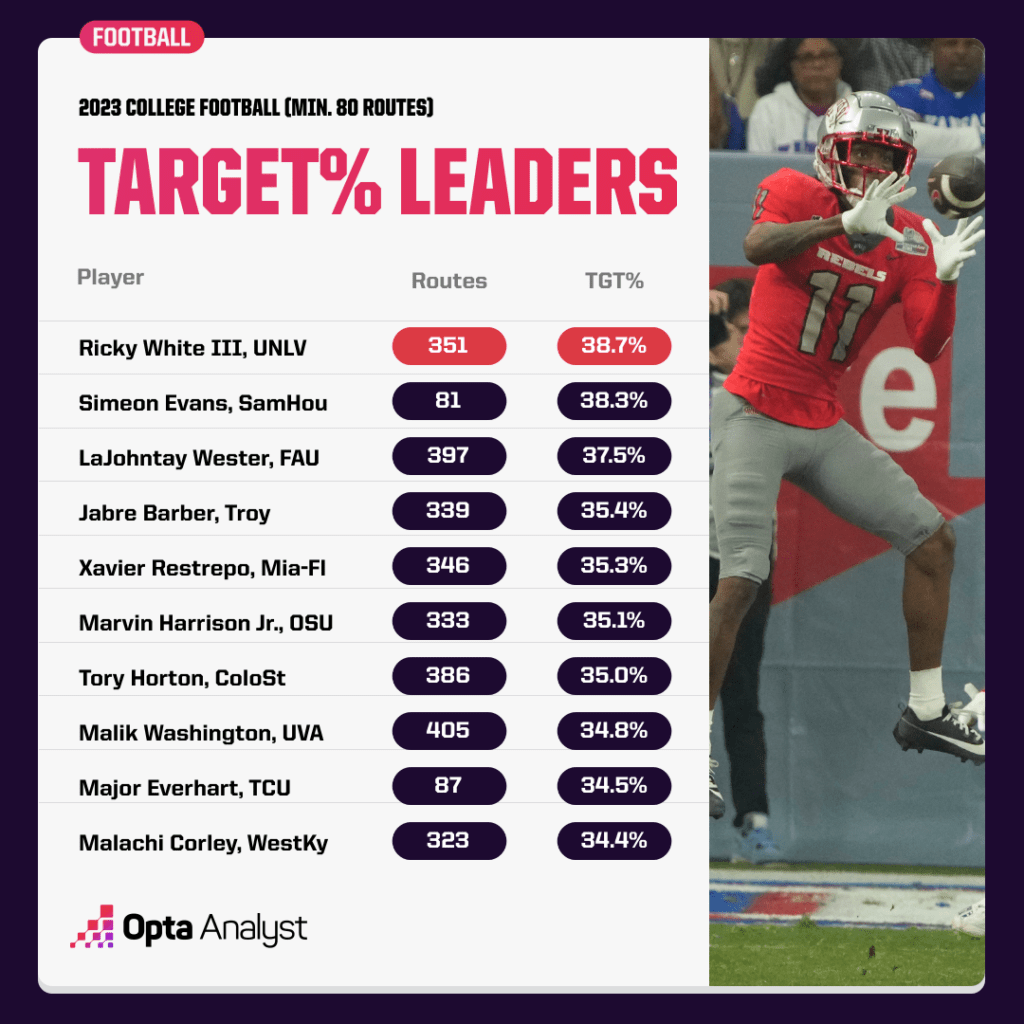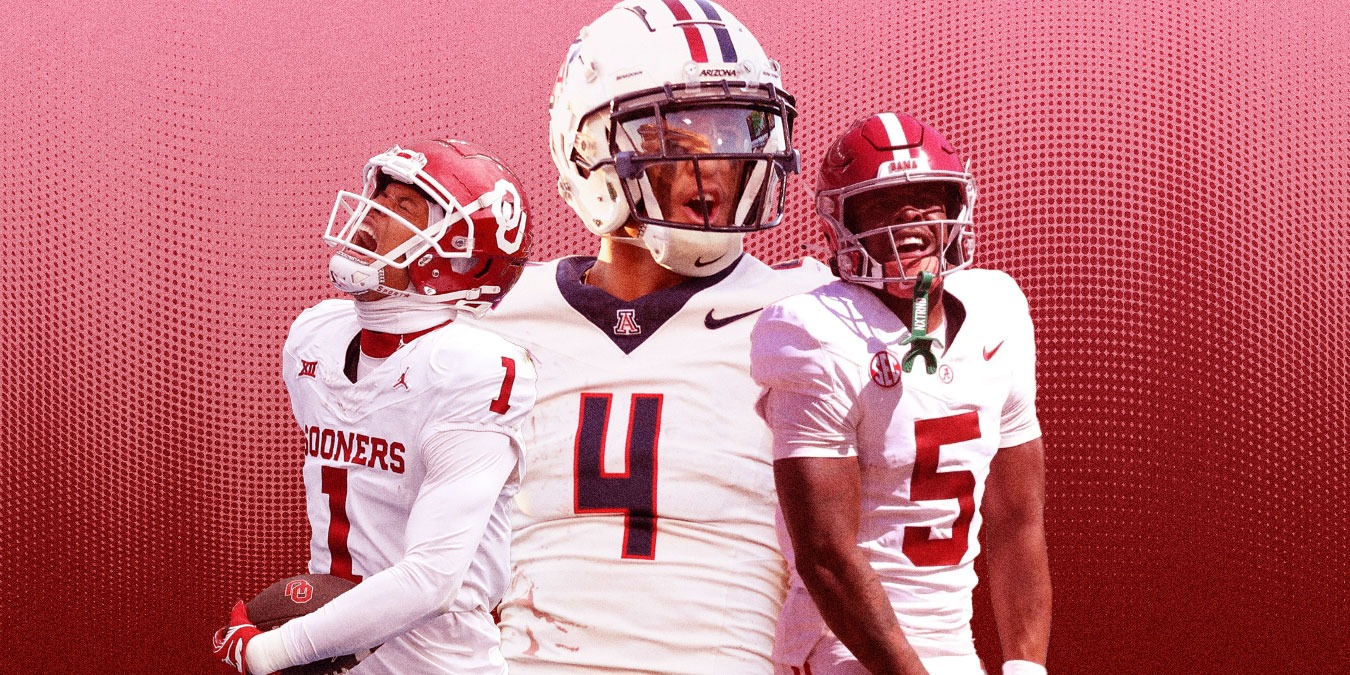With help from our game-tracking data, we’re examining a few wideouts who look poised for breakout in the college football 2024 season.
College football just lost an outrageous group of receivers.
That was clear throughout the 2023 season, but the proof came in April, when NFL teams tied a record by drafting seven of them in the first round.
Marvin Harrison Jr., Malik Nabers and Rome Odunze treated us to one of the closest Biletnikoff Award races ever (Harrison won). All three are professionals now, as are are a big handful of the rest of the elite receivers who played on campus last year.
Good news, though: The continued development of passing offense in college football has meant the continued development of great receiver talent. With help from our game-tracking data, we can closely examine a few players who look poised for 2024 breakouts.
One or two have already become stars and are now looking to make the next step to All-American status. Others will help determine the success of their first-year head coaches. All will be entertaining.
Germie Bernard, Alabama
Last year, Bernard was the No. 4 receiver for a loaded Washington offense. Odunze had a legendary season in front of him, and Michael Penix Jr. also had Jalen McMillan and Ja’Lynn Polk as outlets.
So maybe it shouldn’t be a surprise that Bernard, who’d started his career at Michigan State, was able to fade into the background. That was the case not just for viewers, but for defenses. Bernard posted a 93.0% open rate on his 43 targets – one of the highest marks in the country. The national average for wideouts was a 73.6% open rate, but Bernard was open virtually all the time.

With defenses worried about Odunze and company, Bernard made lots of plays for a national championship game team. He dropped one pass on 43 targets. Even the defenders who were guarding him directly had a brutal time keeping up, as Bernard also posted a way above-average 74.4% burn rate.
His 34 catches for 419 yards and two scores weren’t big surface numbers, but Bernard saved the Huskies by putting on his biggest yardage efforts in games UW could have easily lost (wins over Arizona, Utah and Texas in the College Football Playoff.) When his head coach, Kalen DeBoer, left Washington for Alabama over the winter, he brought Bernard with him.
Bernard was a spring game star for the Crimson Tide and should be one of Jalen Milroe’s primary targets as he moves to a school that was already light on receiving depth and then lost its No. 1 wideout, Isaiah Bond, to Texas. Bernard’s profile will soon rise.
Tetairoa McMillan, Arizona
McMillan was brilliant last year and would’ve gotten more attention if not for playing at a lower-profile school at a time when the sport was overflowing with great receivers. He was productive throughout the year but really got going after Noah Fifita emerged as Arizona’s starting quarterback at the end of September.
And in McMillan’s last four games, he averaged 10 catches for 162 yards. (He totaled 90 for 1,402 on the season – a 15.6-yard average.) Arizona lost coach Jedd Fisch to Washington when DeBoer went to Alabama, but the Wildcats were able to keep both Fifita and McMillan around. That means new coach Brent Brennan, from San Jose State, has a chance to win right away.
The peripheral numbers only make McMIllan more exciting. He had eight contested catches, putting him in the top 15 nationally and within three of everyone except Odunze, who had 19.
McMillan did not record a drop on his 130 targets. The next-most targeted receiver who didn’t drop a pass had 38 fewer passes thrown his way. McMillan is also a strong route runner – his 64.6% burn rate beat the national average by five points – and has already shown he can be the focal point of a strong offense.
His upside in 2024 is to jump up to AP first-team All-American status after being a third-teamer in 2023.
Ricky White, UNLV
White is a rare find in college football today. He’s an elite player for a Group of Five team who remains on that team the season after his big breakout.
An 88-catch, 1,483-yard season gave White the chance to play at all sorts of programs. (His quarterback, Jayden Maiava, transferred from UNLV to USC.) But White remains in Las Vegas with coach Barry Odom and offensive coordinator Brennan Marion. The Runnin’ Rebels have one more season to feed White the ball and go after a Mountain West championship.
Not that feeding White the ball is anything new. His 38.7% target share on his routes last season was the highest rate in the country for anyone running more than 80 routes. (White ran 351.)

White’s excellence is in his consistency and his durability shine more than any one thing he does well. His 60.3% burn rate was just a hair above the national average, and his average depth of target (12.1 yards) was also just a smidgen ahead of average. But White managed a huge workload amid inevitable attention from defenses.
The Rebels will only lean on him more with Maiava in Southern California.
Elijah Sarratt, Indiana
Sarratt was quite simply the hardest man to cover in college football last season. Playing at James Madison, Sarratt posted an 82.0% burn rate – 7.0% better than any other receiver who had 100 targets are more. (Odunze was next, for a sense of how good Sarratt was.)
That translated to 82 catches for 1,191 yards and eight touchdowns for a Dukes team that nearly went undefeated. Sarratt was as sure-handed as he was slippery, only dropping two passes all season.
Last year, Sarratt was doing it against Sun Belt defensive backs. It’s a great league, but it’s not the Big Ten, and that’s where Sarratt will now compete at Indiana.
He followed head coach Curt Cignetti from Harrisonburg to Bloomington after the Hoosiers fired Tom Allen, and now Sarratt’s ability to keep torching defensive backs will weigh heavily on if IU can be competitive in Cignetti’s first year.
Jayden Gibson, Oklahoma
Last year, Gibson was a fun supporting player for Oklahoma as a sophomore. The former high four-star recruit wasn’t a starter, but he played every week and hit a few home runs against outside cornerbacks – like a 60-yard touchdown catch down the right sideline against TCU.
That dimension to his game shows up in the numbers: Gibson’s 21 targets weren’t many, but his average depth of target was 23.4 yards – one of the handful of highest marks in the nation. At the same time, he posted a 76.2% burn rate, an elite figure for any wideout, not just a backup trying to get on the field.
Oklahoma’s offense will look different this year. The Sooners have a new quarterback (Jackson Arnold) and new offensive coordinator (Seth Littrell) running the show. Gibson is still potentially a backup, because Oklahoma has a long list of experienced receivers: Nic Anderson, Jalil Farooq and Andrel Anthony chief among them.
But Gibson was a hot story for the Sooners during spring ball, and his performance last year screams out that Littrell and Arnold need to get him the ball more. Here’s betting they will.
Be sure to check out all our MLB, NBA and NFL coverage, as well as our Oilers-Panthers NHL Stanley Cup Final prediction. And follow us on X and Instagram for more!
